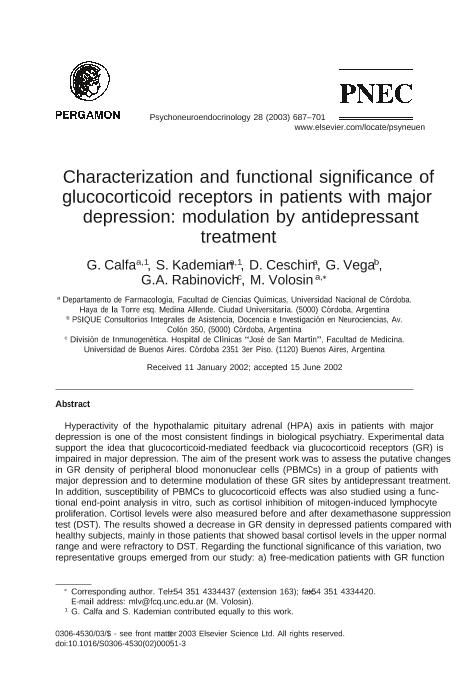Mostrar el registro sencillo del ítem
dc.contributor.author
Calfa, Gaston Diego

dc.contributor.author
Kademian, S.
dc.contributor.author
Ceschin, Danilo Guillermo

dc.contributor.author
Vega, G.
dc.contributor.author
Rabinovich, Gabriel Adrián

dc.contributor.author
Volosin, M.
dc.date.available
2018-07-13T15:41:52Z
dc.date.issued
2003-06
dc.identifier.citation
Calfa, Gaston Diego; Kademian, S.; Ceschin, Danilo Guillermo; Vega, G.; Rabinovich, Gabriel Adrián; et al.; Characterization and functional significance of glucocorticoid receptors in patients with major depression: Modulation by antidepressant treatment; Pergamon-Elsevier Science Ltd; Psychoneuroendocrinology; 28; 5; 6-2003; 687-701
dc.identifier.issn
0306-4530
dc.identifier.uri
http://hdl.handle.net/11336/52030
dc.description.abstract
Hyperactivity of the hypothalamic pituitary adrenal (HPA) axis in patients with major depression is one of the most consistent findings in biological psychiatry. Experimental data support the idea that glucocorticoid-mediated feedback via glucocorticoid receptors (GR) is impaired in major depression. The aim of the present work was to assess the putative changes in GR density of peripheral blood mononuclear cells (PBMCs) in a group of patients with major depression and to determine modulation of these GR sites by antidepressant treatment. In addition, susceptibility of PBMCs to glucocorticoid effects was also studied using a functional end-point analysis in vitro, such as cortisol inhibition of mitogen-induced lymphocyte proliferation. Cortisol levels were also measured before and after dexamethasone suppression test (DST). The results showed a decrease in GR density in depressed patients compared with healthy subjects, mainly in those patients that showed basal cortisol levels in the upper normal range and were refractory to DST. Regarding the functional significance of this variation, two representative groups emerged from our study: a) free-medication patients with GR function comparable to healthy controls, and b) patients showing diminished GR activity. These results suggest a lack of relationship between GR density and cortisol-induced inhibition of lymphocyte proliferation. Patients treated with different antidepressant drugs showed a marked increase in the number of GR sites per cell compared to non-treated. Interestingly, this increase was even higher than in normal subjects. Hence, restoration of GR density after an efficient antidepressant treatment could be an index of an effective modulatory action of drugs on GR expression and highlights the possibility that GR levels might be used as markers of a successful treatment. © 2003 Elsevier Science Ltd. All rights reserved.
dc.format
application/pdf
dc.language.iso
eng
dc.publisher
Pergamon-Elsevier Science Ltd

dc.rights
info:eu-repo/semantics/openAccess
dc.rights.uri
https://creativecommons.org/licenses/by-nc-sa/2.5/ar/
dc.subject
Antidepressant Treatment
dc.subject
Cortisol
dc.subject
Gucocorticoid Receptors
dc.subject
Hypothalamus-Pituitary-Adrenal Axis
dc.subject
Lymphocyte Stimulation
dc.subject
Major Depression
dc.subject.classification
Neurociencias

dc.subject.classification
Medicina Básica

dc.subject.classification
CIENCIAS MÉDICAS Y DE LA SALUD

dc.title
Characterization and functional significance of glucocorticoid receptors in patients with major depression: Modulation by antidepressant treatment
dc.type
info:eu-repo/semantics/article
dc.type
info:ar-repo/semantics/artículo
dc.type
info:eu-repo/semantics/publishedVersion
dc.date.updated
2018-07-11T17:18:40Z
dc.journal.volume
28
dc.journal.number
5
dc.journal.pagination
687-701
dc.journal.pais
Estados Unidos

dc.journal.ciudad
Nueva York
dc.description.fil
Fil: Calfa, Gaston Diego. Consejo Nacional de Investigaciones Científicas y Técnicas; Argentina. Universidad Nacional de Córdoba. Facultad de Ciencias Químicas. Departamento de Farmacología; Argentina
dc.description.fil
Fil: Kademian, S.. Universidad Nacional de Córdoba. Facultad de Ciencias Químicas. Departamento de Farmacología; Argentina
dc.description.fil
Fil: Ceschin, Danilo Guillermo. Consejo Nacional de Investigaciones Científicas y Técnicas; Argentina. Universidad Nacional de Córdoba. Facultad de Ciencias Químicas. Departamento de Farmacología; Argentina
dc.description.fil
Fil: Vega, G.. PSIQUE; Argentina
dc.description.fil
Fil: Rabinovich, Gabriel Adrián. Consejo Nacional de Investigaciones Científicas y Técnicas; Argentina. Universidad de Buenos Aires. Facultad de Medicina. Hospital de Clínicas General San Martín; Argentina
dc.description.fil
Fil: Volosin, M.. Universidad Nacional de Córdoba. Facultad de Ciencias Químicas. Departamento de Farmacología; Argentina
dc.journal.title
Psychoneuroendocrinology

dc.relation.alternativeid
info:eu-repo/semantics/altIdentifier/doi/https://dx.doi.org/10.1016/S0306-4530(02)00051-3
dc.relation.alternativeid
info:eu-repo/semantics/altIdentifier/url/https://www.sciencedirect.com/science/article/pii/S0306453002000513
Archivos asociados
